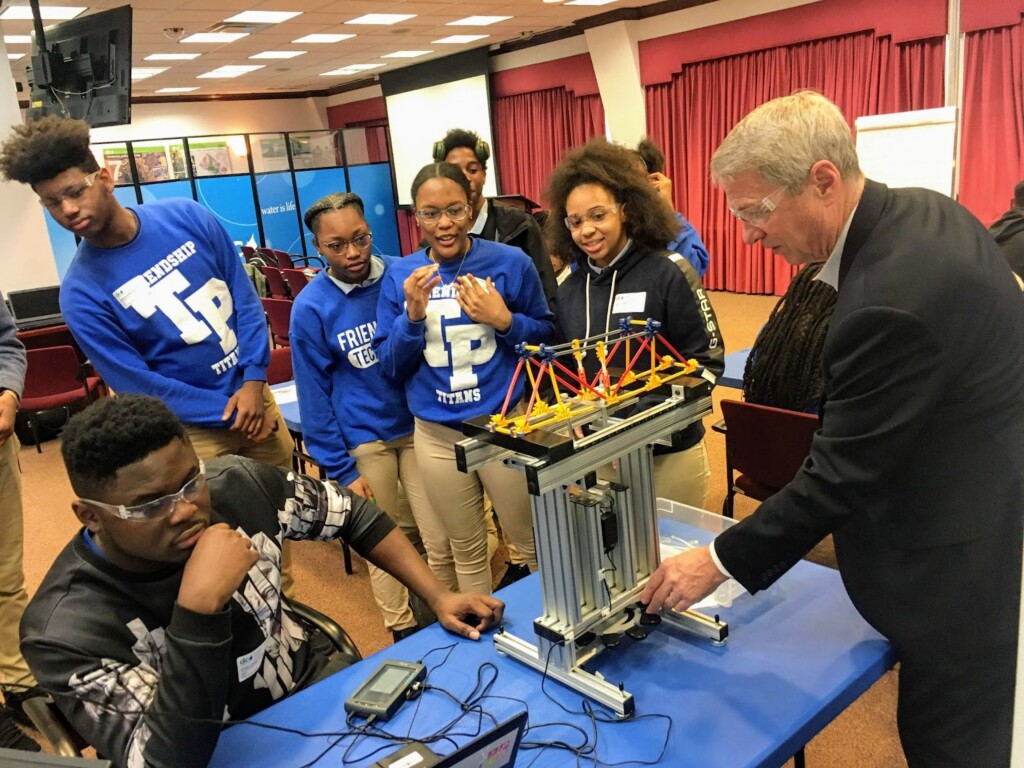Key Points
- NAF shifted to a district approach so that there is community buy-in and engagement; when more than one academy is in one place you can share resources and create the most sustainable model.
- NAF continues to see their programs grow (even during the pandemic) and have further explored how to use technology to provide more access and opportunity for more kids in smaller places where resources are more limited.

NAF, a national nonprofit that began in 1980, brings education, business, and community leaders together to help students become college, career, and future ready. NAF takes a three-prong approach: industry-focused curriculum, work-based learning and real-world industry connections; all of these together help students visualize and create their future.
NAF is not extra, it is totally integrated; students go to all of their classes in small community cohorts throughout the day within a NAF Academy (this is the ideal case but they do have a flexible design that can fit into all kinds of existing public schools). It is a wall-to-wall model with five pathways: Engineering, Finance, Health Sciences, Hospitality and Tourism, and Information Technology. Essential to this design are NAF advisory boards, which are local collaborations between schools and the business community to develop the future workforce through curriculum integration, work-based learning opportunities, and mentorships. NAF created a work-based learning tracker that really looks at the outcomes of what kids get out of the experience, besides just a list of things they were involved in. Over the past five years, NAF has seen a growing group of other themes too (about 10% of academies now); sometimes student and community desires to drive more pathways to be created for specific community industries and needs.
Students can earn a NAFTrack Certification in all approved courses, a credential that signifies to employers that a student is college and career ready. There are three components: a minimum of eighty hours of a qualifying internship, four semesters of career-focused courses and meeting the district requirements for high school graduation. There is not only one pathway to a NAFTrack Certification; besides the curriculum utilized in its five academy pathways, NAF accepts third-party and state-aligned courses such as Advanced Placement (AP) and International Baccalaureate (IB), early college/dual credit, and courses through Project Lead the Way,
Students can earn a NAFTrack Certification in all approved courses, a credential which signifies to employers that a student is college and career ready.
Marissa Wicklund
NAF shifted to a district approach so that there is more community buy-in and engagement; when multiple academies are in one place resources can be shared and the most sustainable model is created. Even community business partners have decided to use NAF as their workforce development strategy because of the ability to be a tailored solution targeted towards a business partner’s needs. One such community-driven example kicked off in early 2020 in Puerto Rico, when NAF and UTC partnered to create two NAF Academies of Engineering. “UTC is incredibly proud to partner with NAF, an organization that is transforming the STEM learning environment with tangible, hands-on learning opportunities for high school students in underserved communities,” said Greg Hayes, UTC Chairman and CEO. “These academies will expose generations of students in Puerto Rico to STEM classes, mentorships and company internships, bringing to life what a future career in engineering and technology can look like.”
NAF continues to see their programs grow (even during the pandemic) and have further explored how to use technology to provide more access and opportunity for more kids in smaller or remote places where resources are more limited (this includes the idea to create more virtual internship opportunities with business partners). KnoPro, a tech-based project that NAF developed, is an internship-like experience that is totally self-guided where students are given Challenges and Skillbuilders, such as the AI For Good Challenge. It was co-designed with teachers and business partners to provide students with real-world, project-based career readiness experiences.
Coming soon! The Open Data Index for Schools (ODIS), powered by NAF in collaboration with the NYU Marron Institute of Urban Management; a resource that will more strongly clarify the challenges and stressors that communities face in order to offer more targeted support for high school students. You can sign up here to be notified when it launches and to receive more information.
Marissa Wicklund is the Advocacy Manager at Getting Smart. She has been in education for over 10 years and has taught Special Education and Visual Art with students of all grade levels K-12, and loves anything related to cooking, baking, and nutrition.


